About Wm Oakley who was awarded the US Medal of Honor
This prestigious Medal was awarded to a Wivenhoe man in 1898
Research by Michael Smither
This is the story of Wm Oakley who was born in Aberdeen in 1857 and came to Wivenhoe around 1859 of parents who were married in St Mary’s Wivenhoe. At the age of 22, William emigrated to the US in 1880 where he signed up to serve in the US Navy. He was involved in the Spanish American War of 1898 where he won the US Medal of Honor for outstanding bravery. Although he became a US citizen, he came back to Wivenhoe in 1912 where he died 6 years later in 1918.
The Oakley family originated from Glemsford in the late 1700s
The overseers of the poor of Glemsford in Suffolk made efforts to apprentice out pauper children so to that they would not become a burden on the parish and also to give them a trade; most would end up in the Courtauld silk mills at Pebmarsh and later Braintree, a different fate would await the three young sons of Robert Oakley and Hannah Merrils who were married at Glemsford in 1776.
Robert and Hannah had eight children in total, although only four survived into adulthood, the family clearly fell on hard times as two of their remaining three sons appear in the Overseers of the Poor Register of Apprentices Book where, in 1803, we find John Oakley apprenticed to Thomas Mason, Oyster-Dredger & Fisherman, of East Donyland, Essex, until of age. In 1806 John’s younger brother, James, then aged only 11, was apprenticed to the same Thomas Mason who is now listed as a fisherman of Wyvenhoe. Thomas Mason was also originally from Glemsford. There is no record of when the third brother, Robert (William’s Grandfather) arrived in Wivenhoe but was presumably around the same time.
The Wivenhoe connection from 1849
William’s parents, James Abbott Oakley and Hannah Webb were married on 21st Dec 1849 at Wivenhoe, St Marys. The newly married couple left Wivenhoe not long after their marriage as by the time of the 1851 Census we find them in Aberdeen living at 42 Regent Quay along with their new-born son, who was duly enumerated as “Not Baptized Oakley”, aged 3 days; James & Hannah christened their new-born son James Robert at St. Nicholas, Aberdeen on 1st May.
Three daughters followed; Elizabeth in 1852, Sarah the following year and then Margaret in 1855, before William arrived at 6am on the morning of Monday 31 Aug 1857 at 5 Hanover Street.
James and Hannah returned to Wivenhoe not long after William’s birth, probably in 1858, as their next daughter, Ann was born here in 1859. The family are then listed as living on New Road (what would later be re-named Alma Street) on the 1861 census, in 1862 the family was completed with the arrival of their third son, Frank.
The arrival of the Railway in 1863 prompted a mini house building boom in Wivenhoe, Queens Road being one of the roads added at this time. We don’t know exactly when the Oakleys moved from Alma Street to Queens Road but it may have been when it was newly built, they were certainly there by the time of the 1871 census and although the houses are not numbered on the census, we now know this to be the modern day number 46.
We know little about William’s education other than the fact that it was deemed to be inadequate later in life, like virtually all the men in the family he became a mariner.
Emigrated to the USA in 1880
William left Wivenhoe in 1880, travelling first to London, where he boarded the Anchor Line “Elysia”, bound for New York, arriving at Castle Garden, Lower Manhattan on 21st April.
For some reason William’s name was recorded as James upon arrival and this is the first of many inconsistencies found in his official records, most of which relate to his stated age and date of birth which are almost invariably incorrect. We don’t know how William spent the summer of 1880 and for some reason his name does not appear to be on the US Census taken in June that year, the next we hear of him is when he arrives at Boston harbour and enlists in the US Navy.
William joins the US Navy late in 1880
William’s first enlistment began as an ordinary seaman at Boston Navy Yard in November 1880 where he was assigned to the USS Wabash, a Civil War era screw frigate then being used as a receiving ship. In May 1881 he was transferred down to the Brooklyn Navy Yard where he joined the USS Colorado, another Civil War era receiving ship, before embarking on the USS Constellation.
The Constellation had also seen service in the Civil War, before being used, first as a receiving ship and then as a training ship; it was also used for Irish famine relief in 1880, when ballast was replaced by 2,500 barrels of flour & potatoes. The USS Constellation was the last sail only warship designed and built for the United States Navy, it is also the only ship that William sailed on that is still afloat and can now be visited in Baltimore Harbour as a museum ship.
After serving on the USS Constellation, William was transferred south once more to the Naval Station at Norfolk, Virginia where he joined another receiving ship, the USS Franklin. From here William was assigned to the USS Tennessee, the flagship of the North Atlantic Squadron; with a crew of 480 and 355ft in length it was the then largest vessel in commission in the US Navy. Shortly before the end of his first enlistment William’s brother Frank arrived In New York onboard the White Star Line “Germanic”.
William’s second enlistment began at Brooklyn Navy Yard in Feb 1884 where he joined the USS Colorado, a receiving ship, before being assigned to the USS Saratoga, a Sloop of War which was then some 40 years old. William was now employed as a Cox and spent three years on the Saratoga before being discharged. It was after this enlistment that William made his first return to the UK in the summer of 1887.
A third enlistment in the US Navy in 1887
William’s third enlistment started once more at Brooklyn in July 1887 where he joined the USS Vermont, a ship that had actually been laid down in 1818 and had only been completed (some thirty years later) as the shipyard considered it to be a fire hazard. By then it was totally outdated and un-seaworthy and only fit for stores and accommodation. William was then assigned back to the USS Saratoga between Oct 1887 and 1888 before returning to Boston (USS Wabash) at the end of 1888. He then travelled back down to Brooklyn where he re-joined the USS Vermont.
After the Civil War, the US Navy was not a high priority and was quite literally left to rot. Shipbuilding was also mired in corruption and political cronyism. This played a major role in the election of 1884 that saw the Democrats returned to power for the first time since the Civil War with Grover Cleveland as President. Cleveland appointed William C. Whitney, a New York banker, to run the Navy department. Whitney declared that the US “had no vessel which could have kept the sea for one week as against any first-rate power”. Whitney imposed a cap of 20% of original cost on repairs, effectively condemning the entire fleet. An inventory of Navy depots uncovered $1m in rotting clothes and enough canvas to rig the entire British Fleet.
The reforms that Whitney introduced first bore fruit with ABCD Class ships. The ABCD Class were effectively hybrids, being both steel hulled and steam powered but also fully rigged for sail. Many in the US Navy were suspicious of steam power, especially as the US lacked overseas coaling stations vital for re-fuelling. The first of the new fleet that William served on was the “C” from the “ABCD” the ‘USS Chicago’, which he served on for one year between 1889-1890, he then spent a month on the ‘USS Yorktown’ before returning once more to the UK in the summer of 1890.
1890 – Fourth & Fifth Enlistments
William re-joined the US Navy at Brooklyn for his fourth enlistment in September 1890 before joining the newly commissioned USS San Francisco a few weeks later. The San Francisco was the last US Navy cruiser to be fitted with sails (they were soon removed) and carried 350 tons of coal giving a range of 3,949, miles, this could be increased to 850 tons and 9,589 miles.
William’s fifth enlistment (1893-1896) saw him promoted to Gunner’s Mate Second Class and was spent on the USS New York. The New York was the sister ship of the ill-fated ‘Maine’; although designated ACR2, owing to delays in the construction of the Maine the New York was actually the first armoured cruiser to enter service. At launch it was the fastest armoured vessel in the world and with six 8-inch guns the most heavily armed cruiser in the US Navy.
1897 William’s sixth enlistment
William’s sixth enlistment started in April 1897 on board the USS Marblehead and this was the ship that he would be serving on at the outbreak of the Spanish-American War. There had been an on-going insurrection against Spanish rule in Cuba since 1895, indeed Forrest’s Shipyard of Wivenhoe had supplied six gunboats to the Spanish Navy in order to help suppress the insurgency (one of these gunboats would fire the opening shot of the war from the Spanish forces). By 1898 the Spanish had resorted to ever more desperate measures including the removal of rural populations to urban areas which resulted in widespread famine.
The US, whilst trying to remain neutral, watched with increasing alarm and the USS Maine was dispatched to Havana, officially to protect US interests, but also as a show of strength.
On 15 Feb the USS Maine exploded in Havana Harbour with the loss of 261 crew; prior to Pearl Harbour, this was the single worse loss of life in US Navy history. The cause of the explosion has never been settled beyond doubt, although it may have been the result of a bunker fire the feeling at the time and (more importantly) the conclusion of a Board of Inquiry was that it was the result of a Spanish Mine, this conclusion led inexorably to war.
Disruption of communications between Spain and Cuba
One of the first objectives of the US Government was to sever communications between Spain and Cuba that travelled via transatlantic telegraph cable; this could only be achieved by physically cutting the cables themselves and the work would have to be undertaken close to where the cables came ashore in order that they could be located on the sea-bed. It should be noted that the Americans made sure that contact between Havana and Key West, Florida was maintained throughout the war as they had an informant in the Havana telegraph office relaying intelligence that was said to have been on the President’s desk within five minutes.
The Navy had little or no experience of such an operation and originally planned to use gunboats, before realising that open top rowing boats would be required in order to get close enough to the shore. The cable cutting crew consisted of two such rowing boats, one from the USS Marblehead and one from the USS Nashville each with a crew of 26 (all volunteers), mostly US Navy, to actually haul up and cut the cables but also some US Marines to provide covering fire. The two rowing boats had support from two gunboats as well as the Marblehead and Nashville themselves, the shells of which were whizzing barely feet above the sailors’ heads, the risk of friendly fire was all too real. The cables came ashore at a cable house that was heavily protected by Spanish forces in rifle pits ranged along the shore, the US sailors were armed with no more than handguns in case their boat was washed ashore.
Cutting the transatlantic cables
Once the heavy and heavily encrusted cable had been located it had to be hauled onto the bow of the boat and this had the effect of dragging the boat under the waves. The cable, rubber coated and about the thickness of an arm then had to be cut and this proved to be arduous and lengthy work. Each cable had to be severed twice so as to take a section out and make repair impossible, the crews had expected to find two cables but found a third.
It was whilst attempting to cut this third cable that Spanish reinforcements arrived and started to machine gun the US forces who at that point decided that discretion was the better part of valour. The whole operation, starting at 7 am, had lasted 3 and a quarter hours.
Several men were wounded
Upon their return the USN Surgeon duly filed his report noting Patrick Reagan (shot through the head) as the first casualty of the war and Herman Kuchmeister (shot through the jaw) as fatally wounded, Kuchmeister, after two years in hospital and much surgery however, would survive. One casualty was shot through the liver another received a fractured leg, three more suffered gun-shot wounds.
For a detailed account of the actions of these men who spent three hours in this successful attempt to cut the cables and to see a picture of the cable, click here
Heroic effort was recognised by Medals of Honor for everyone involved
Every man that returned from the cable cutting operation would receive the Medal of Honor, nearly half of the total awarded for the entire Spanish American War came from this one operation.
The Marblehead continued around the south coast of Cuba and, on 7 June along with the auxiliary cruiser Yankee, captured a bay that the Americans had identified as a suitable site for a port and coaling station, Marines from the Marblehead raised the Stars & Stripes at the lower end of the bay and named it in honour of their Captain, Bowman McCalla, it is known to this day as McCalla Point
The USS Marblehead
The USS Marblehead remained in Cuban waters until September, when she sailed for home, dropping anchor at 4pm, on 9th September at Boston Harbour.
Cuba was granted Independence after the War
Following the Spanish American War, Cuba was finally granted independence, but with certain strings attached, these came in the form of the Platt Amendment, a series of eight pledges that the Cuban government had to adhere to, the seventh of which was the following:
“That to enable the United States to maintain the independence of Cuba, and to protect the people thereof, as well as for its own defense, the government of Cuba will sell or lease to the United States lands necessary for coaling or naval stations at certain specified points to be agreed upon with the President of the United States.”
The Coaling Station chosen by the US was that captured by the US Marines from the Marblehead in June 1898 and the stars and stripes flies there to this day. McCalla Point lies at the southern end of Guantanamo Bay.
William moves to a new ship in 1899
William transferred to the USS Indiana in April 1899 and it was on her quarterdeck that he received the Medal of Honor on 5 Nov 1899.
Shortly after receiving the Medal of Honor, William applied to become a naturalized US citizen before returning to the UK, this would be the last time he saw his father who passed away in December 1900.
William arrived back in New York on 25 Mar 1900, for the last time as an alien, he became a US Citizen two days later.
William’s Promotion and Seventh Enlistment
William was promoted to Gunner’s Mate First Class and served nearly all of his next three enlistments on the USS Kentucky.
The USS Kentucky was launched, with much fanfare, with her sister and twin the USS Kearsage on 24 March 1898, shortly after the loss of the Maine. The Kearsage was launched with the traditional champagne but this was not felt appropriate for the Kentucky, there was clearly an obvious alternative; Spring Water from Sinking Spring Farm, Abraham Lincoln’s birthplace.
The ship was launched by Miss Christine Bradley, daughter of the Kentucky Governor, the family were teetotallers. This managed to offend some Kentuckians on two levels, some hurled bottles of Bourbon at the launch, whilst others preferred spring water from the spring of the late President of the Confederate States Jefferson Davis’ farm.
The Kentucky embarked on sea trials during the summer of 1900 before leaving on a tour of the Far East; she would not return to the US until May 1904.
A fascinating insight into life onboard the Kentucky during this time is provided by the ship’s onboard magazine which was produced to a highly professional standard, even including adverts. The magazine was named “Open Door” which summarized US trade policy with China at the time, a policy that the US was very keen to protect.
At the end of this enlistment, William returned to the UK once more, arriving back in New York on 27th August 1904.
EIGHTH & NINTH ENLISTMENTS
William’s 8th & 9th enlistments were spent concurrently. 1904 and 1905 were spent largely on training exercises as part of the North Atlantic Fleet.
In 1906. the Kentucky was in Cuba helping to deal with a Sugar Insurrection and 1907 saw the tri-centenary of the creation of Jamestown, celebrated with the Jamestown exposition.
In December 1907 President Roosevelt assembled the US Navy at Hampton Roads, Virginia, for a round the world voyage that would become known as the Great White Fleet. The years preceding the Great White Fleet had seen a massive arms race in Naval power with the US primarily worried about Japan and Germany. Roosevelt, who had previously been under secretary of the Navy, set about bringing the US Navy up to strength. Although only nine years old by the time of the Great White Fleet, the USS Kentucky was now one of the oldest ships in the fleet, but that was probably of little concern to the crowds that cheered the Fleet off in December from Hampton Roads. What the crowds at Hampton Roads didn’t realise but the US Navy top brass almost certainly did was the fact that the entire US fleet had been rendered virtually obsolete before it left port.
The previous December HMS Dreadnought had been commissioned; the British had just changed the rules of the game. The Great White Fleet spent the entirety of 1908 on a round the world voyage returning to port in Feb 1909, just in time to see Roosevelt leave office.
William’s final two years in the US Navy
William’s final two years in the US Navy were spent on the USS Michigan, one of the first US dreadnoughts. By this time the US Navy was experimenting with flights to and from warships, the first take off was successfully achieved in November 1910 and the first landing in January 1911, this would prove to be the genesis of the modern day aircraft carrier.
RETIREMENT & RETURN
William was eligible for retirement at 75% of his final salary at the age of fifty, and after 30 years of service (4 Sep 1911) length of service during the Spanish American War being counted as double.
William’s younger brother Frank died in April 1911 and he applied for retirement shortly afterwards, at which point he was recommended for advancement in the rating in order to increase his pension. He retired from the US Navy & the Michigan on 4 Nov 1911.
On 15 Nov 1911 William was given permission to reside in England for one year and he duly arrived at Southampton on 12 Jan 1912 onboard the White Star Line “Oceanic”.
This was the same Oceanic that nearly collided with RMS Titanic in April that year as she set sail on her ill-fated maiden voyage. The Oceanic would later recover three bodies from the ‘Titanic’ that had been left drifting in a collapsible lifeboat A. One of the bodies never recovered was that of Giovanni Sacaggi, the son-in-law of William’s first cousin, Sarah Ann Harlow.
William would never return to the US
William would never make the return journey to the USA, which was obviously slightly more hazardous after August 1914. Had he done so it is more than likely that he would have been buried along with some of his crewmates at Arlington National Cemetery, as was his right. William’s prolonged stay in the UK appears to have been with the approval of the US Navy as they were still paying his pension up to the time of his death.
William dies in 1918 and was buried in an un-marked grave
By the end of the Great War, William was terminally ill; his elder brother James died on Armistice Day at West Ham and was buried in Wivenhoe Cemetery the following Saturday. It is unlikely that William attended the funeral as he died at 9am the following Wednesday (22nd Nov) and was himself buried the following Sunday where he lay in an un-marked grave and it would appear, largely forgotten for the next 100 years.
On Midsummers Day in 2018, a headstone was finally erected in honour of William Oakley, one of only 10 such Medal of Honor headstones in the UK.
A small dedication ceremony was also held in May 2019 to coincide with Medal of Honor Day. As a final mark of respect there are plans to erect a Blue Plaque at no. 46 Queens Street, where William lived, consent from the current owner was not a problem, indeed the plaque was requested. William may have been the first US citizen to live at number 46 Queen’s Road, but he certainly wasn’t the last.
Michael Smither
June 2019

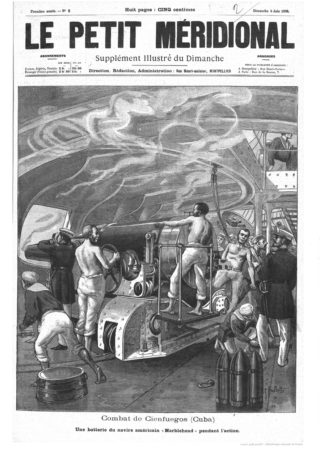


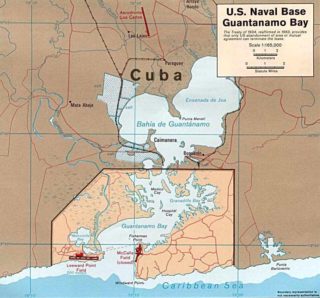
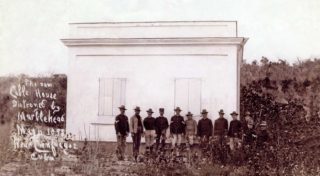
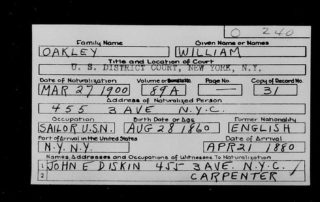
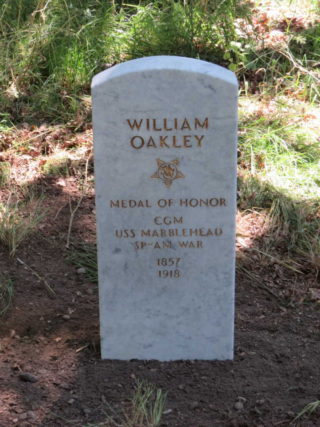





Comments about this page
Sterling research and hugely invaluable work. I know a little something of this story.
Add a comment about this page